This FR is the follow up of my SGN-NGO report. Tokoname is like Roissy-en-France : nobody had ever heard of the place before they built the new international airports of Nagoya and Paris.
And even today, I wonder how many readers knew about Tokoname before reading this.
The employee at the connection counter of NGO will turn out to be amazingly inefficient. I can see my BP and the lounge access invitation already prepared on her desk, so it should be a matter of tens of seconds?
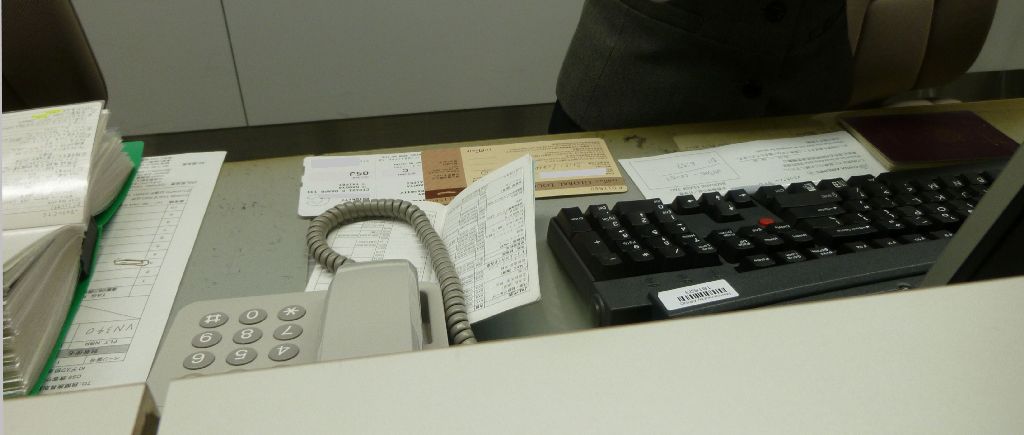
I give my passport, and then my Taiwan resident card which justifies that I do not have an onward ticket from Taiwan. She will scrutinize it during an excessive amount of time (if you know Japanese, you can guess the approximate meaning of written Chinese, but the reverse is not true).
I had asked for a window seat on the right, but the pre-assigned seat is an aisle seat on the right. She apologizes, tells me that the neighbor (window) seat is free and that she is nearly sure that it will remain so, that she is unsure to be able to change my seat, but my experience of Japan is that you only need to stay the time it takes to get what you legitimately want, without arguing: the mere psychological pressure of a customer who does not leave is enough. She indeed eventually types lots of things on her keyboard, and then places several phone calls (I have a passenger with an aisle seat, but he would like a window seat; can I change it?). My Japanese is good enough to follow and I marvel: how could it be impossible to change a seat? She types again and changes my 5G into a 5K. All that for that, no less than fifteen minutes for what would take a couple minutes elsewhere!
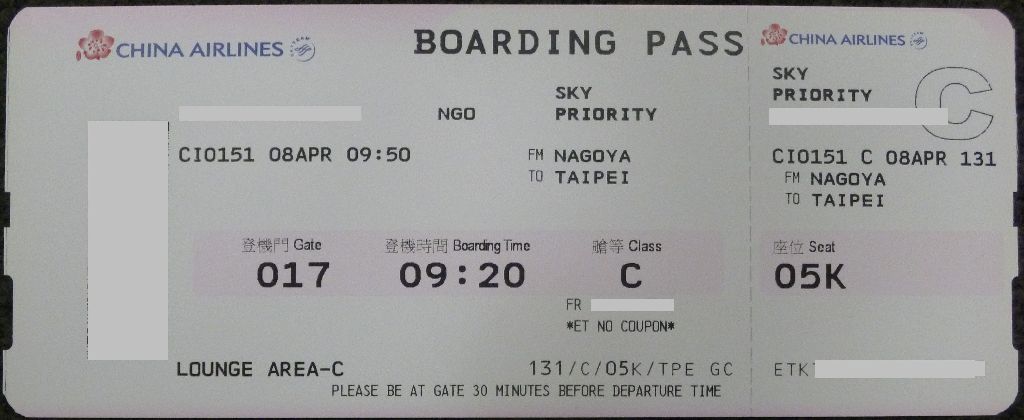
Note that she forgot to scribble on that BP like check in staff all over the world love doing.
It was a unique opportunity to have an immigration stamp from Nagoya, but I had been lazy and had not filled in the immigration form in the plane, and 2h15' was not much to discover an airport, including its J lounge, especially after wasting a quarter of an hour to obtain the BP I wanted.
The layout of NGO is exceedingly simple: an inverted T, half of it international on the left, half of it domestic on the right in grey. Runway 18/36 is parallel to the corridor of gates 19-24.
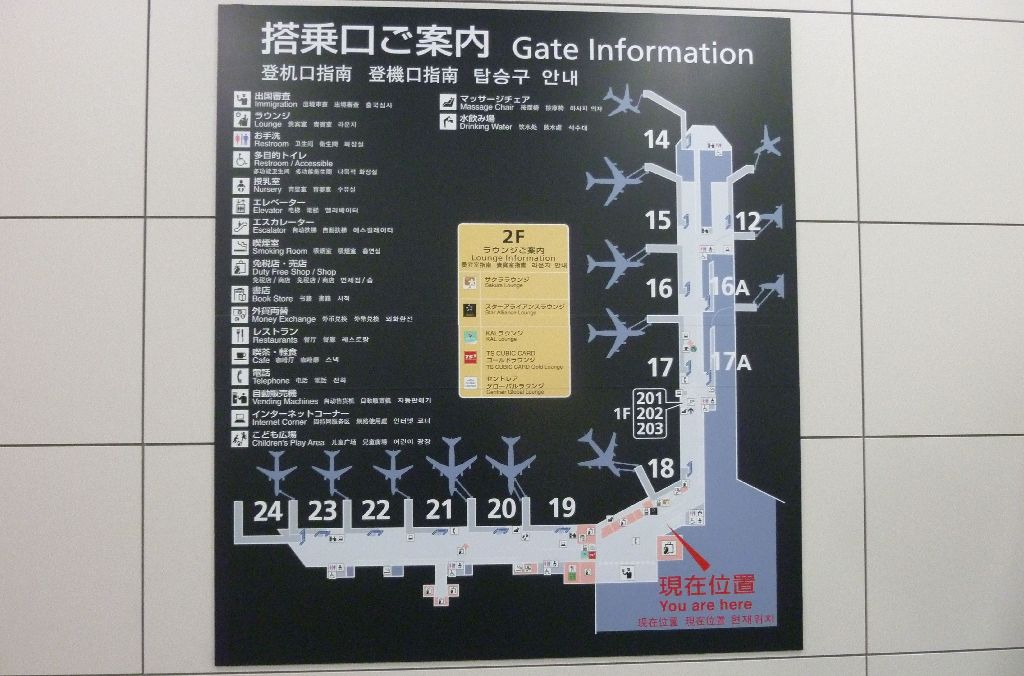
The domestic traffic is further away, visible from gates 12-14. There is of course much less variety than in the international section. In the distance, an HX cargo plane, in front of three ANA Dash 8 and the FW Dash 8 photographed when taxiing in.
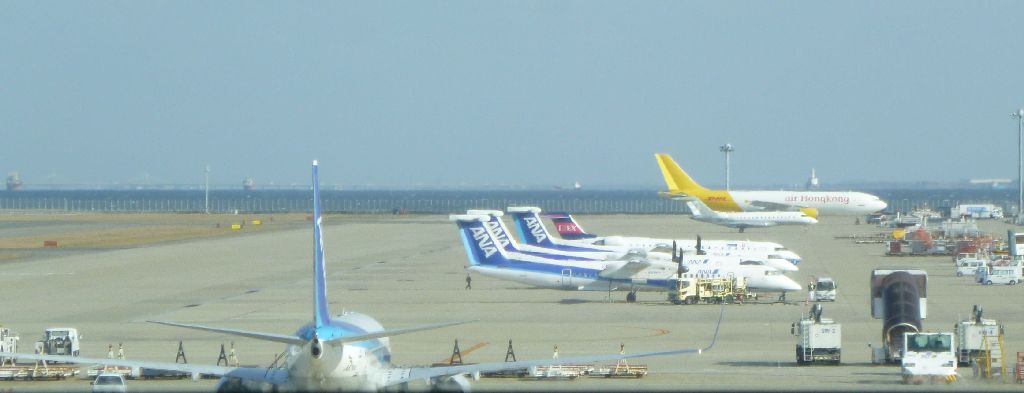
A BC 738
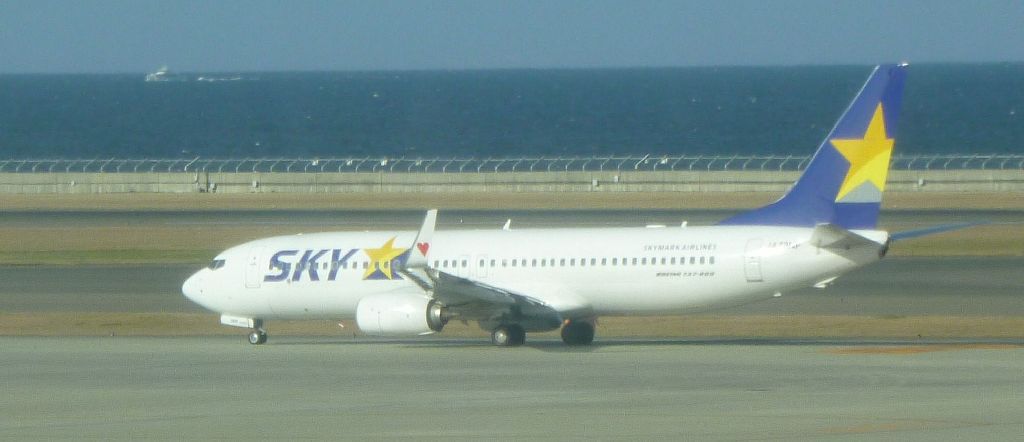
The toilets in NGO are worth visiting. All spotless clean, better say it once for all.
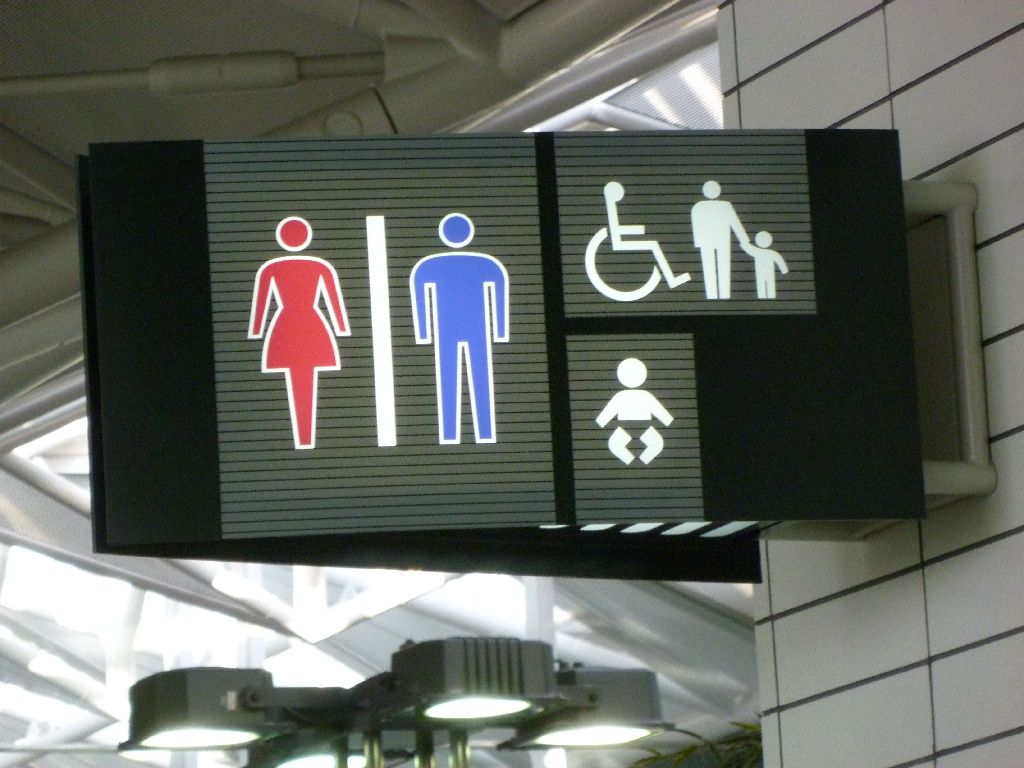
Here, it is simple: from left to right for Mrs., for Baby and for Mr.

When you wear diapers, you apparently should manage by yourself.

Well, no quite, the Japanese/Korean/Chinese/English text says that these toilets are for families.
The text which is in Japanese only adds that this room has a nursing corner and that fathers can enter if they knock on the door, and please lock the door when you are inside.
I knocked, there was nobody and the door was not locked. In order to give a last chance to save the modesty of a mother, the sofa for nursing an infant is masked from the door by a partition on the left.

The other toilets that I visited were even more interesting. The overall layout is strictly symmetrical male/female, with the same room in the center for Baby + Mom + Dad if he knocks first.

In the male side, the washbasins are quite standard, with one equipped for hold bars designed for handicapped users.

The toilets themselves are more complex, because there are three different configurations in three booths. From left to right: Japanese type (with baby carrier), Western with handicapped holding bars and baby carrier, and the same without a baby carrier.

But according to the map, the toilets for handicapped users who are really handicapped are accessible to paraplegics, ostomates and the general public. I did not know then what ostomate means, and since the Japanese version is osutomeito, i.e.; the phonetic transcription of the English word, it did not help. Long explanation made short, Wikipedia taught me that this meant roughly people who have an external pouch for collecting urine or feces. There is indeed an unusual bed to help emptying the pouch.

There is also of course a toilet seat equipped with all the necessary handle bars, and call buttons at several heights

In the Japan – Taiwan disabled accessibility match, Japan scores in NGO a spectacular point against the world champion.
Massaging armchairs at 200 JPY for ten minutes
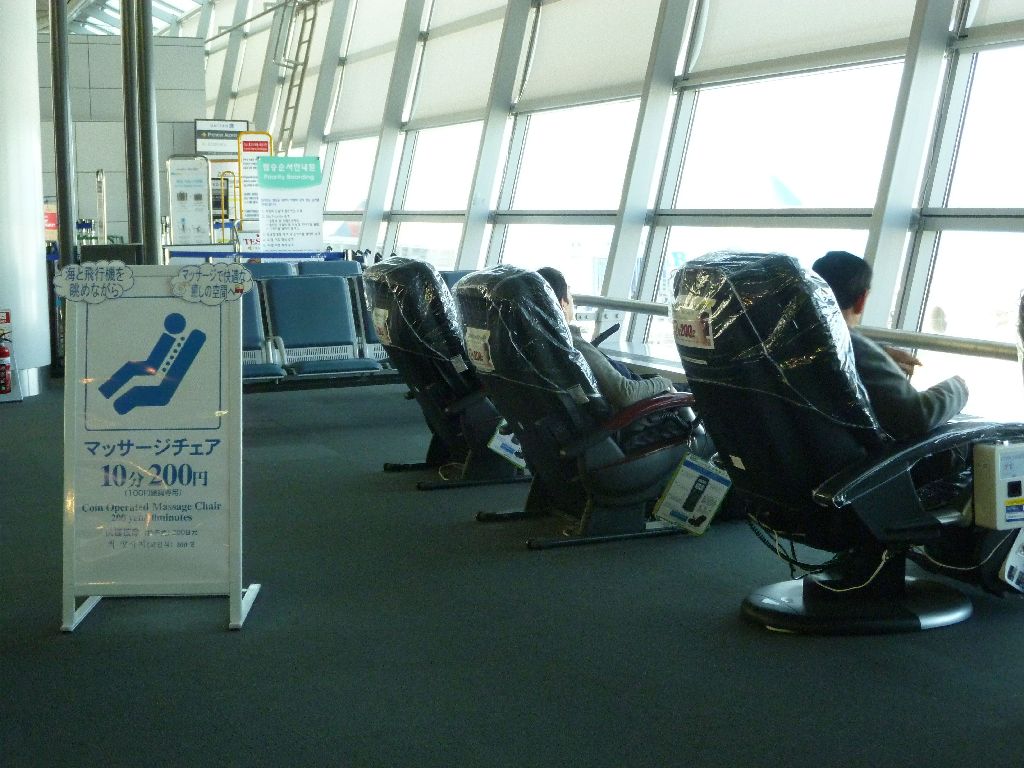
Use of this equipment is entirely free. It is only recommended not to exceed fifteen minutes.
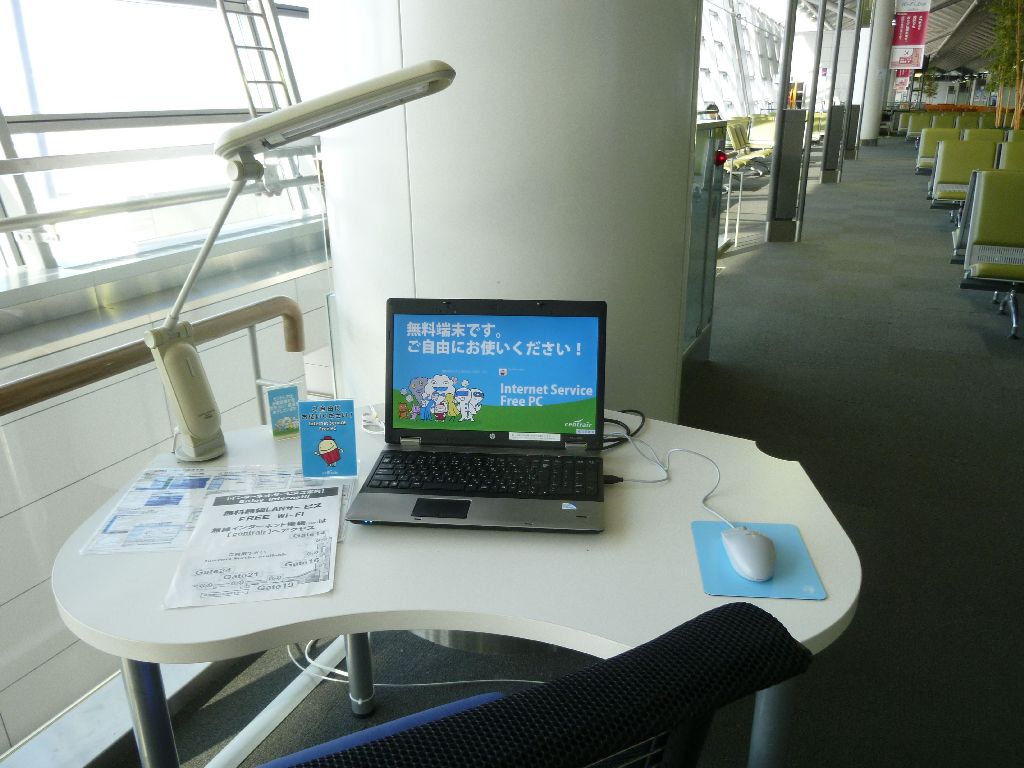
This provides me the opportunity to display the corporate home page which changed since I left SGN.

I have not understood what these small platforms are for. There is an interesting variant to be explored by the specialists of airside sleeping.
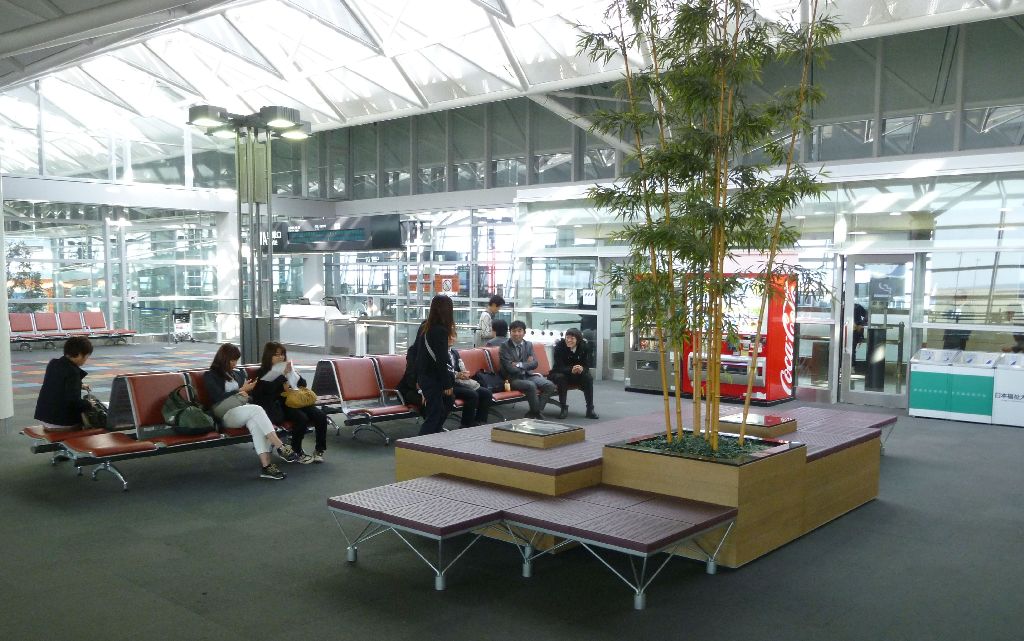
BYOL (Bring Your Own Laptop) internet Zone
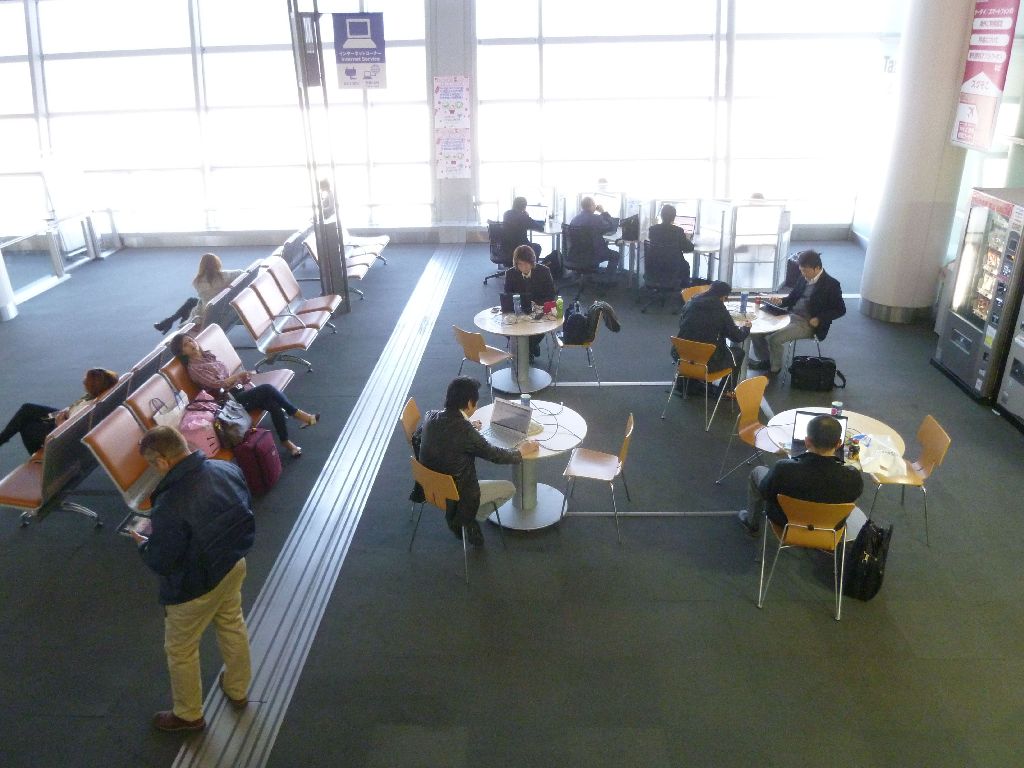
There is also a kids' corner which appear to satisfy them.

There is a foreign exchange office next to the arrival airside, which I advise not using unless you have USD, EUR or possibly CHF.

For these are the margins on each transaction:
USD 2.8%
EUR 3.2%
CHF 4.8%
SGD 7.4%
GBP 8.6%
CAD 9.5%
AUD 10.3%
NZD 11.6%
THB 15.1%
DKK 15.3%
NOK 15.3%
MYR 16.0%
CNY 17.5%
TWD 17.8%
SEK 18.6%
PHP 19.2%
KRW 20.4%
HKD 23.3%
AED 23.4%
BRL 30.0%
IDR 61.3%
The record is held by the Indonesian rupiah, bought back at less than half its selling price!
It is not correlated with the probable number of PAX from these countries: the margins are high for the KRW, the HKD and the TWD, and higher than for the NOK which is unlikely to be handled often here.
NGO is not fully spotter friendly, because of long slopes towards jetbridges which reduce the length of accessible windows.
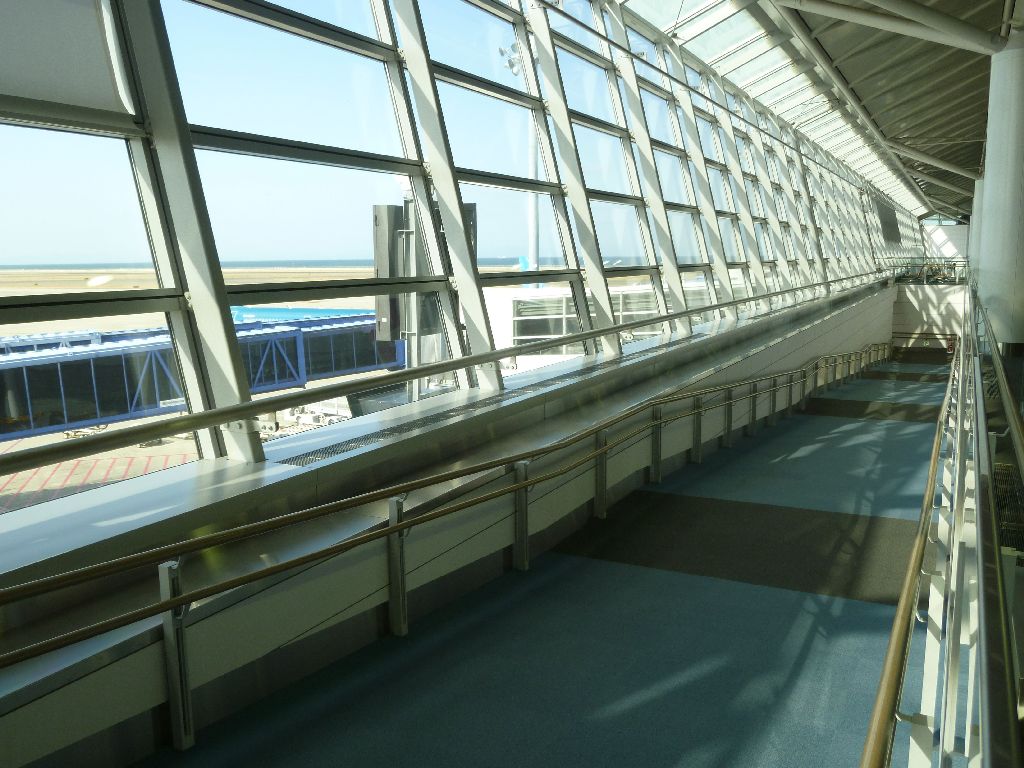
By the way, when the saw me actively plane spotting, the JAL crew reaching their plane waved at me with friendly welcome in English. That was nice.

Even there, you can take the picture of an aircraft. An ordinary ANA 737, as an example:

The departing flights in Japanese to make it local. Note that two thirds of the destinations are written in ideograms, and are therefore in the Greater China (the visa China, HKG, Taiwan).

Let us begin plane spotting with the VN A321 which brought me here.
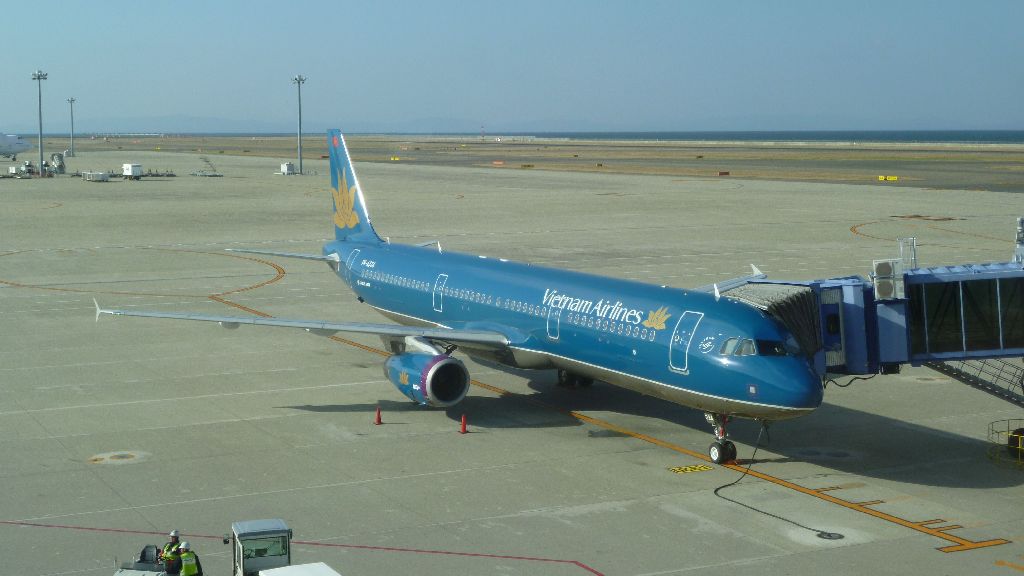
The front landing gear marking is 320 for the A32x family (I saw that in another FR too).

The ANA 737 ANA look like toys next to the Dreamlifter, and yet they are closer.

The alignment of stabilizers at gates 19 to 24
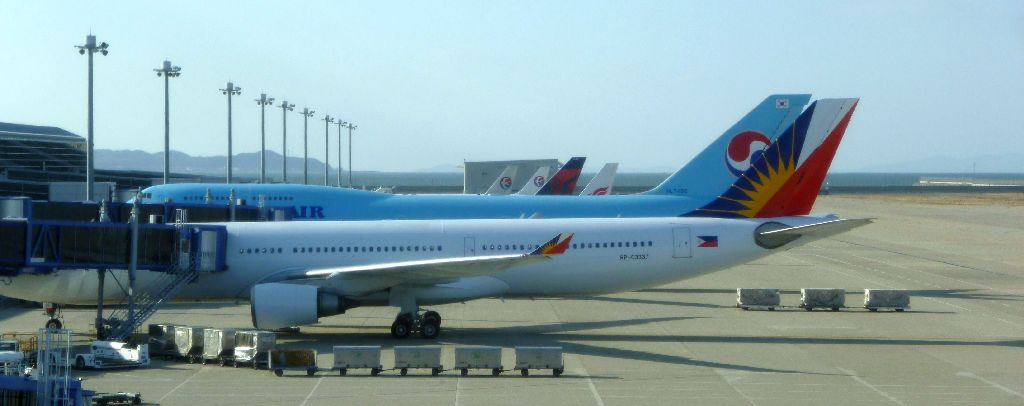
The TG 773 TG which landed just after me

CZ A320, VN A321 and TG 773, pier side

Arrival of an SQ 333, lateral view
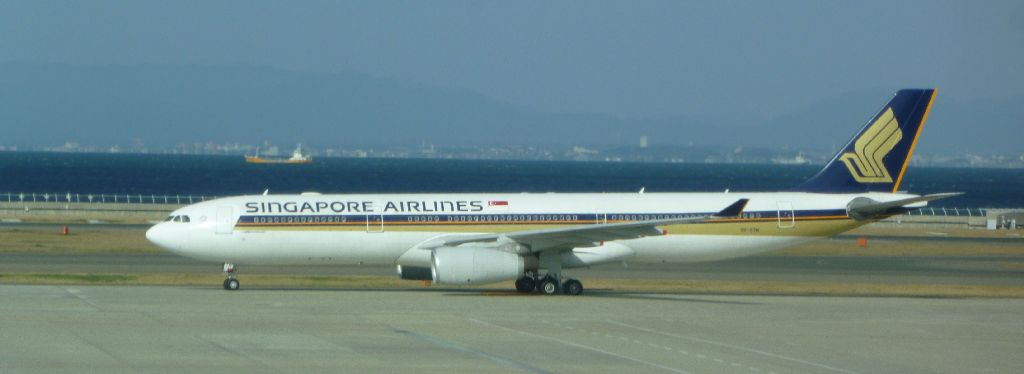
… and front view
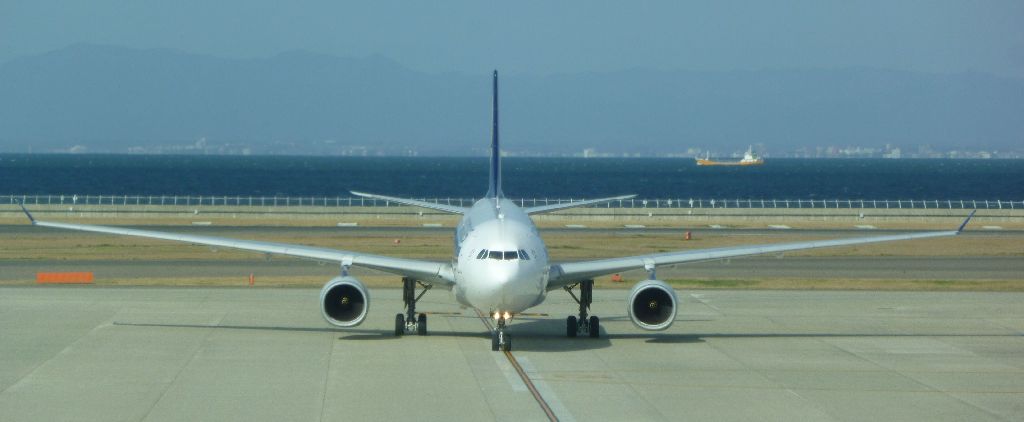
PR 333
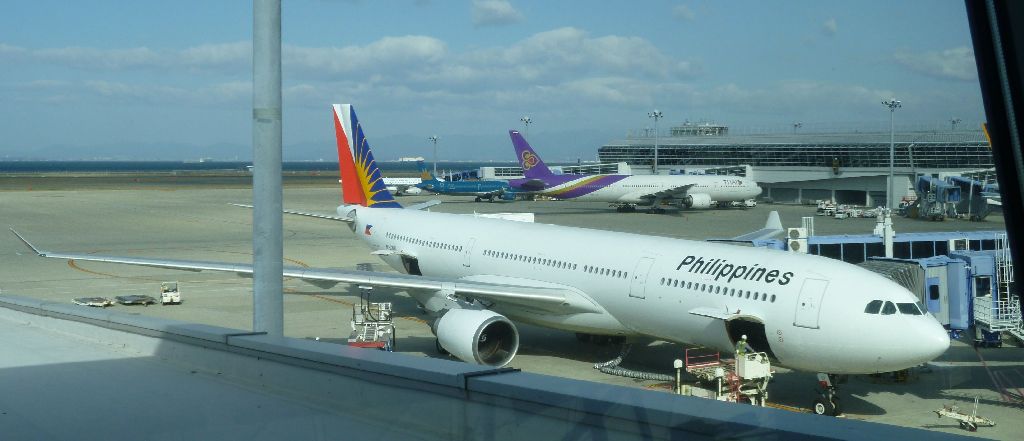
KE 744 heading towards ICN

… and the first crew members who reached the boarding gate

There are many ANA planes in NGO, but they were all 737 and Dash 8. This picture summarizes it.

CA 738 without winglet

The A321 which brought me to NGO is being pushed to a remote parking space; I guess it will leave too late to remain pier-side.

A plane-spotter soon to board towards China

A departing JAL 767 behind the Dreamlifter.

The Dreamlifter that I never tire of looking at (granted, it is quite ugly, but it is such a rare opportunity)

It took me by surprise: the CI 333 which is going to bring me back to TPE has just arrived.

Time is passing by: I have exhausted plane spotting opportunities and I do not have much time left to explore the lounge, which is multi-airline only.

A good point: the invitation card has a detachable tip which is date stamped when entering and serves as an unlimited re-entry pass. This is a wealthy change from the single access lounges… only that this lounge will turn out to be less than enjoyable. A very long access corridor (the architect made some mistake there)
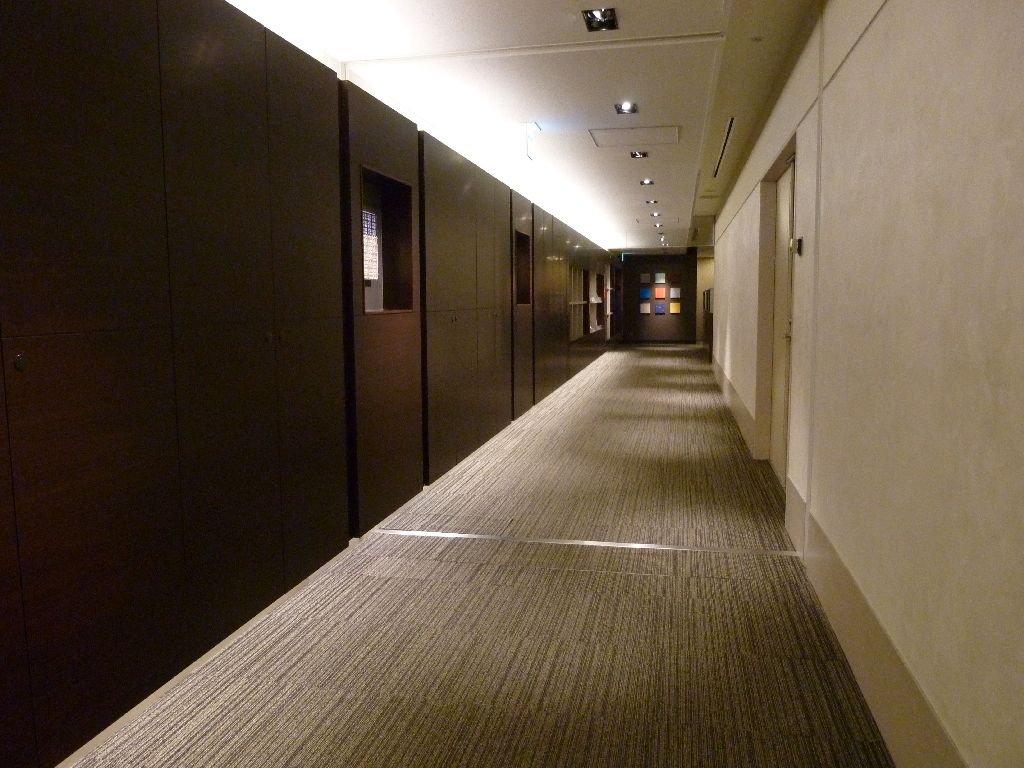
I did not check if there was also a charge for using these massaging armchairs.

This looks marginally easier to drive than a 333.
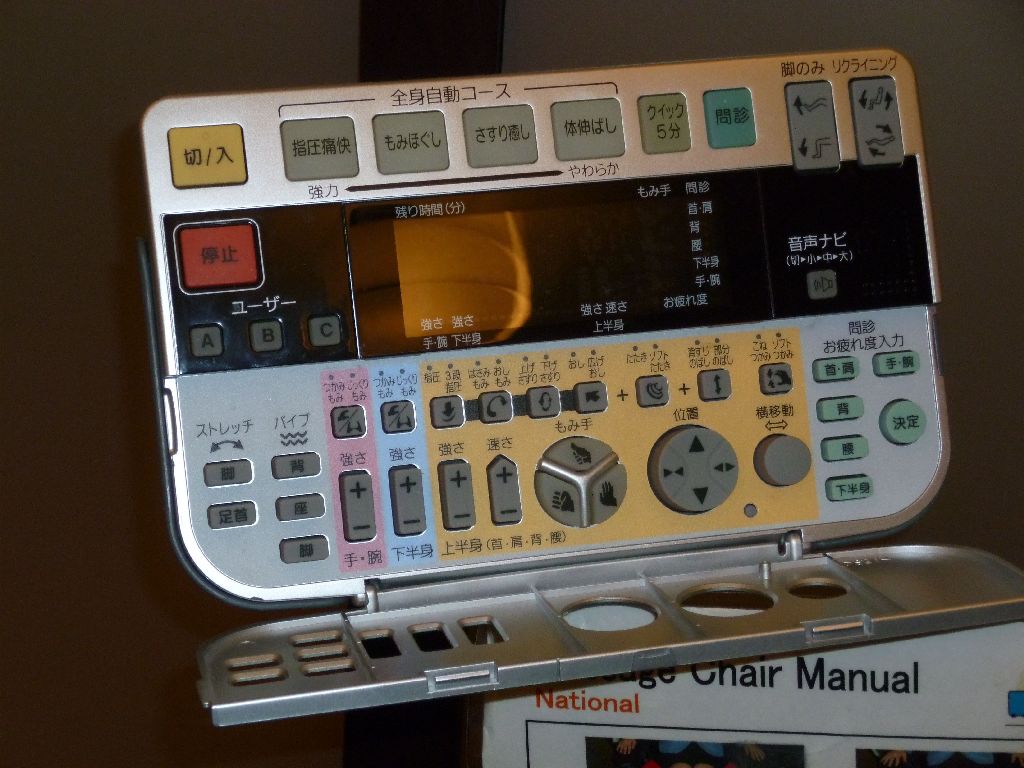
Arrival in the lounge, which is completely windowless, to be avoided by claustrophobics and plane-spotters.

Usually, I lower the toilet seat cover before taking the picture, but there, it went up automatically when I opened the door. You can't see it, but the toilet seat is heated: this is welcome option in winter in the usually unheated toilets of Japanese homes, but completely useless here.
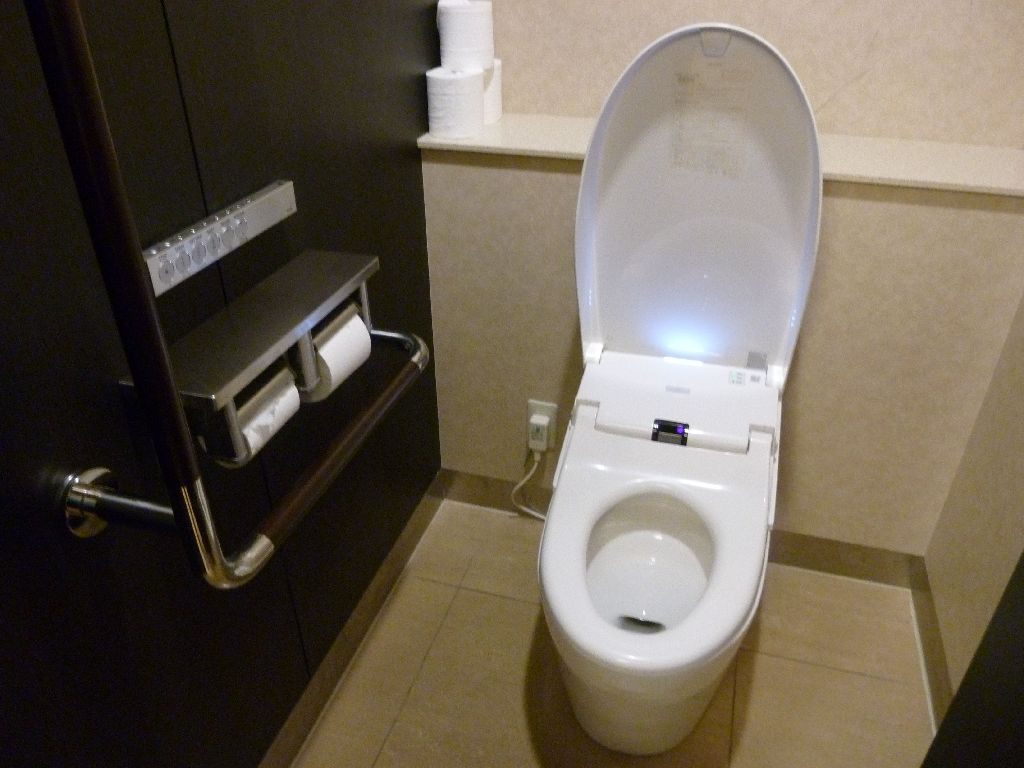
The dashboard is by Toto, the #1 of sanitary equipment in Japan

Food? Really minimal, just have a look:

The one and only bottle of wine!
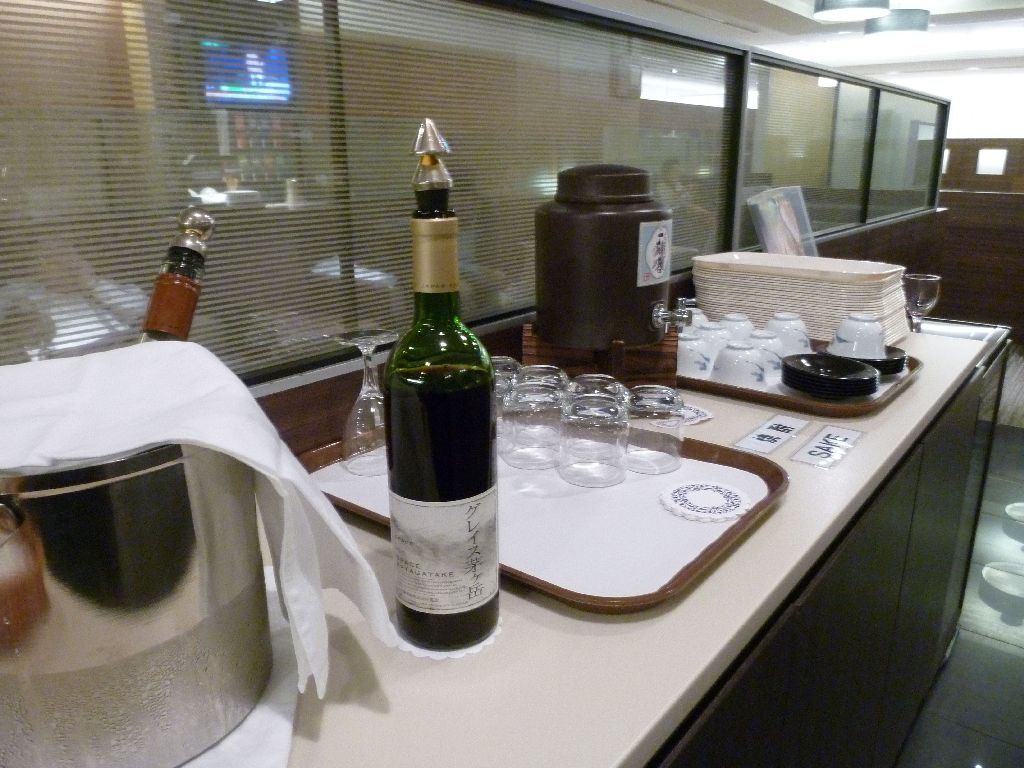
My only compliment for that coffee is that its quality helps manage the transition from Vietnamese excellence to Taiwanese disaster.

Drinks with little or no alcohol

I'll let my readers make disparaging comments about the alcoholic drinks only.

The cookies are not Delicious, but Excellent, which does not stop the food in that lounge to be very Skyteam Europe-like.

The places for internet and nicotine addicts, respectively. Never is very welcoming, but when you are in withdrawal, you can endure any hardship.

Vietnam is part of the countries rated as internet enemies: FR is not blocked like in Mainland China, but the Facebook link generates an error and one of the unexpected censorship side effects was the impossibility to recharge by Skype account, where I had not selected the auto-recharge option. Only once I had reached that lounge could I recharge my account.
A bulky staff oversees the lounge from the back, with a closed and unfriendly face. Despite my Japan-loving tendency, I found it hard to feel at ease in this place.

The friendliest there were the man and the woman at the front desk, both when I arrived and when I left.

It was time to get closer to B-18351, which was pier side,

…photographed from all angles by the author,

… as well as by these young plane spotters

Boarding is being prepared; each person obviously knows what he/she should do, because in a few minutes, the gate shifted from the a few idle staff providing information status to J+Elite+priority boarding status.



This time, I turn left

A detail which was a good omen: a FA helps a PAX place his hand luggage + laptop + duty-free bag to free the aisle.
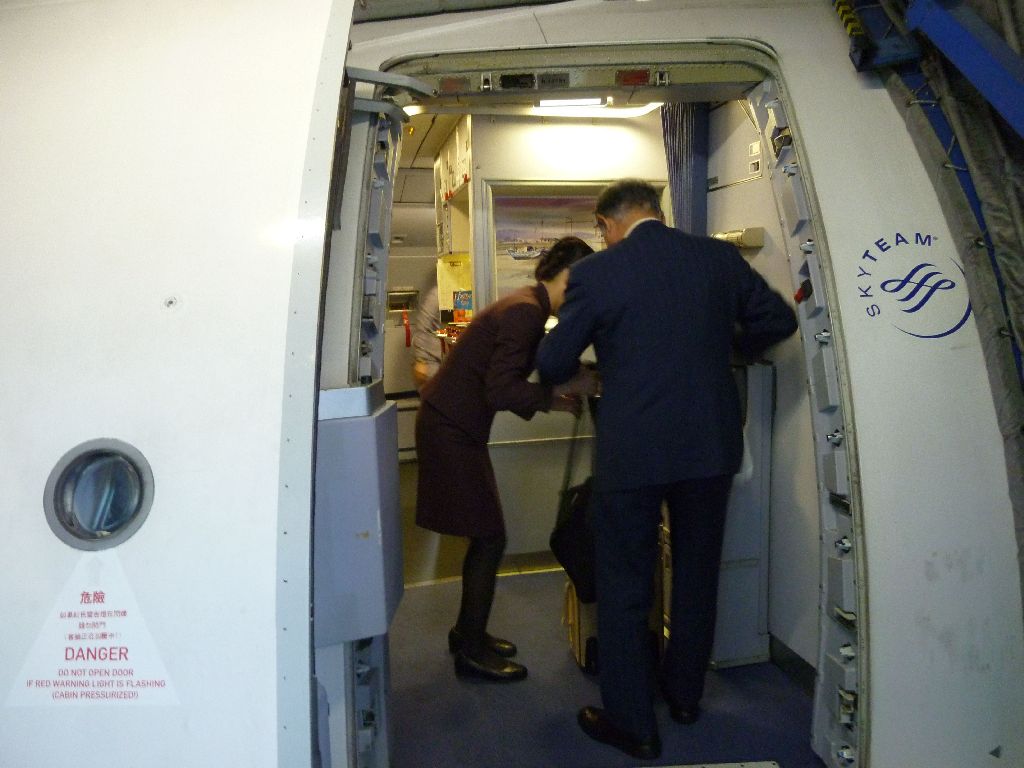
The J cabin: six 2+2+2 rows, only 30% full

Since I am nearly the first in the plane, I go beyond my row to complete my FR's iconography, asking on the way to the FA waiting for the first Y PAX at the other plane door:
- Excuse-me, can I take some pictures?
- Please do, take your time.
I had forgotten that he was Taiwanese and spoken in Japanese (I always find it difficult to switch between Japanese and Mandarin), and he answered immediately in English. A plus for the FA rating, even though all Taiwanese study Japanese in high school.
During the welcome speech, the FA mentioned that there were a (several?) Japanese FA(s), and the Japanese version of the various announcements was amazingly fast and clear.
Small wonder CI has Japanese FAs: there is a huge Taiwan – Japan traffic.

Still only one PAX, presumably with Elite status
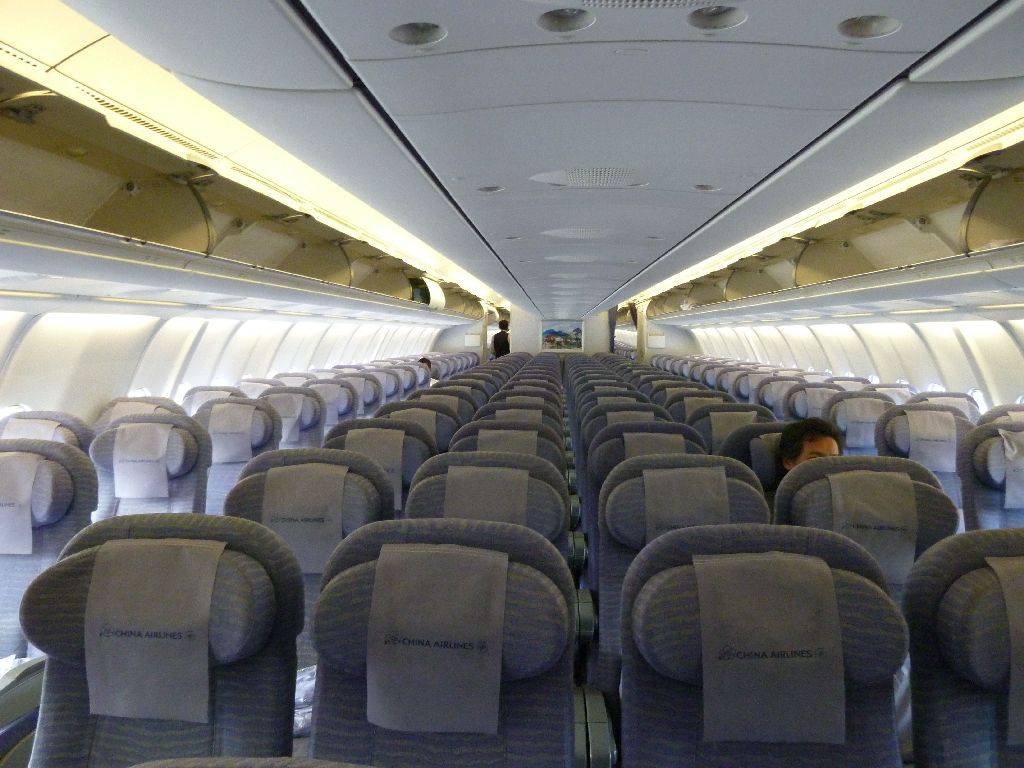
Back to my seat:
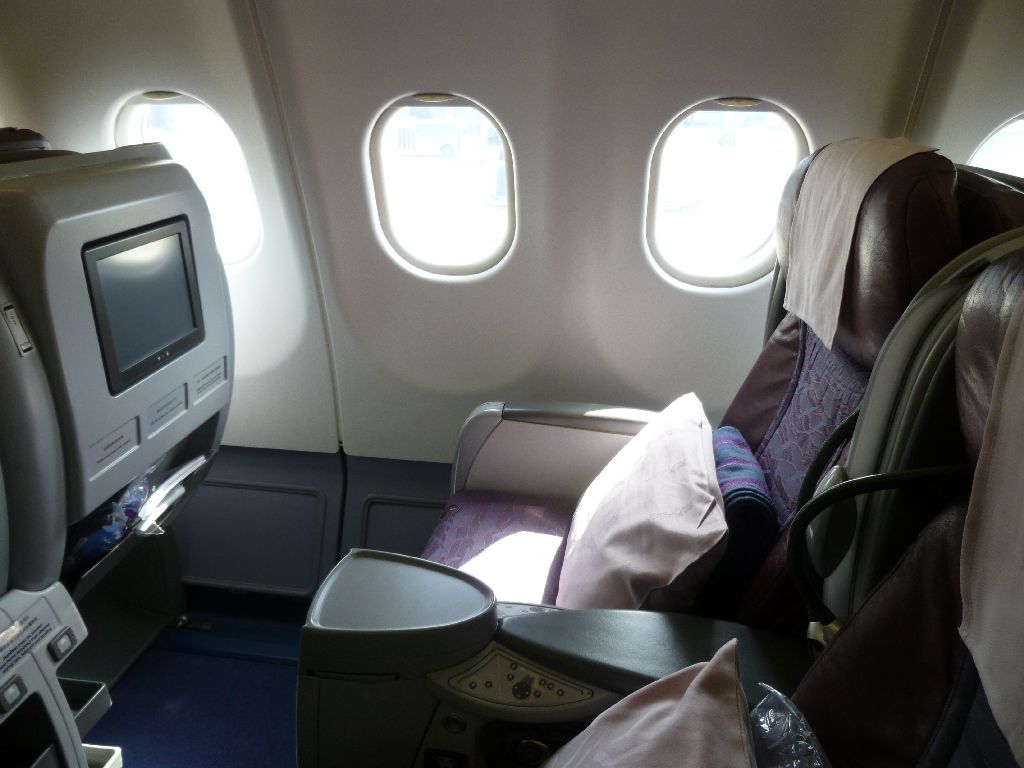
The tray of the welcome drinks: the FA thought it useful to remind that she should not be photographed. Of course, and I showed her the picture to free her mind of worries about it.

I lift my glass to the health of DURIAN and Leadership

The contents of the bag of nuts and other stuff
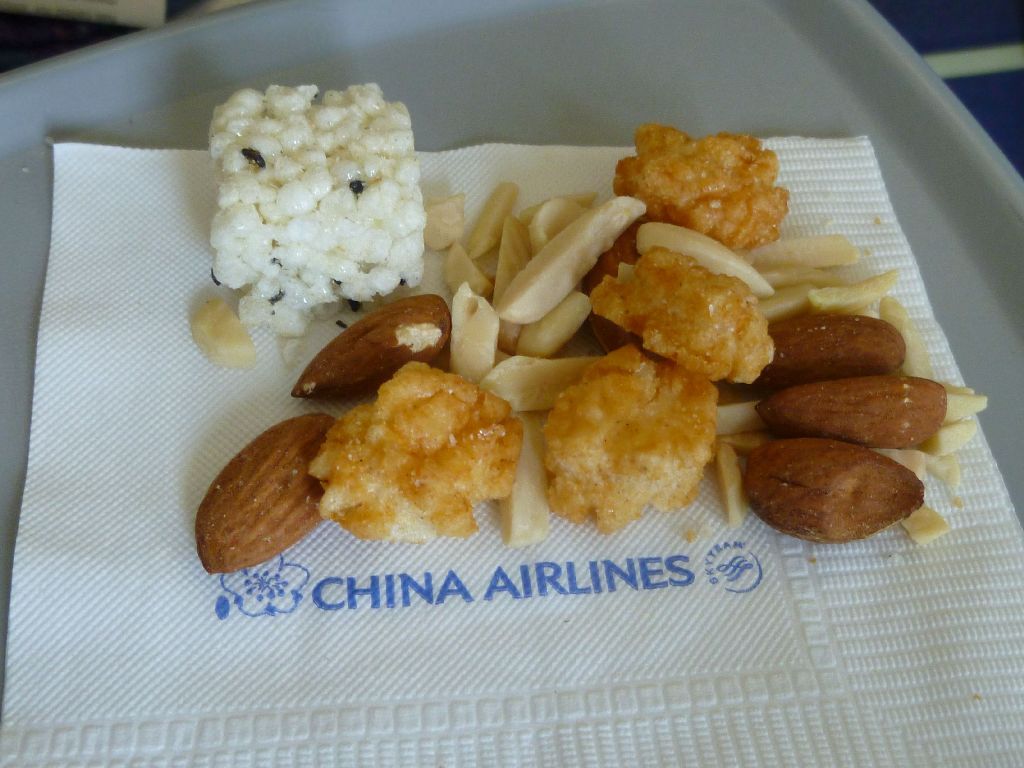
The safety card
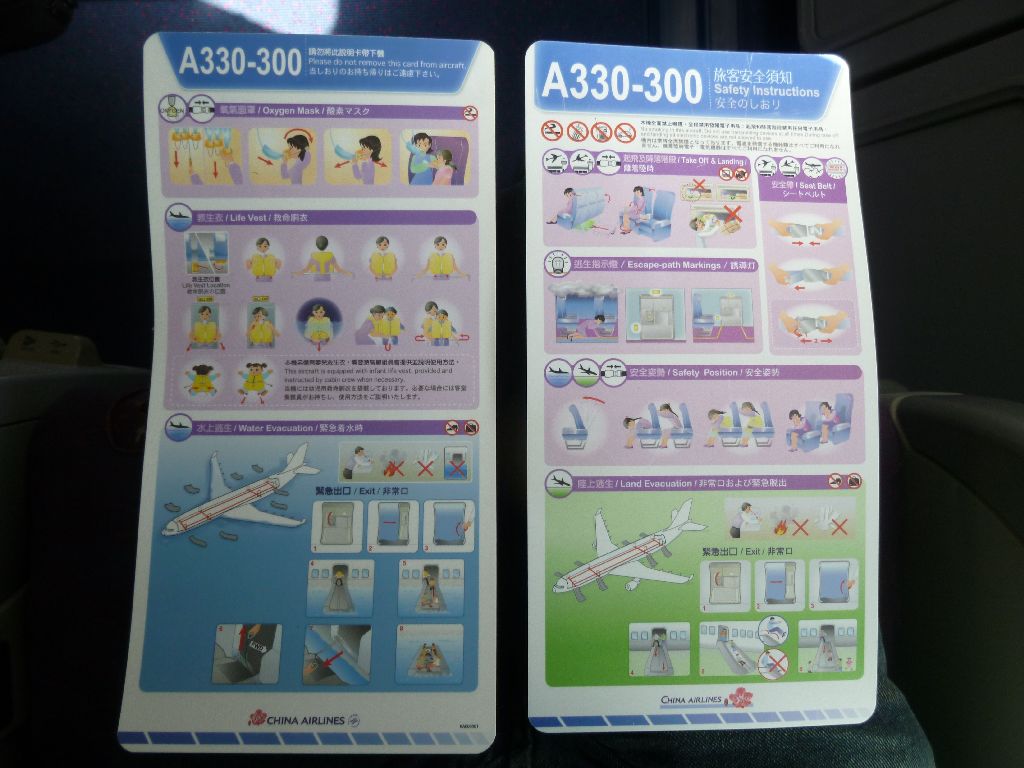
Like in VN's A321, this is a regional configuration, so this is a toboggan seat, but I had neither time nor intention to sleep on that flight.
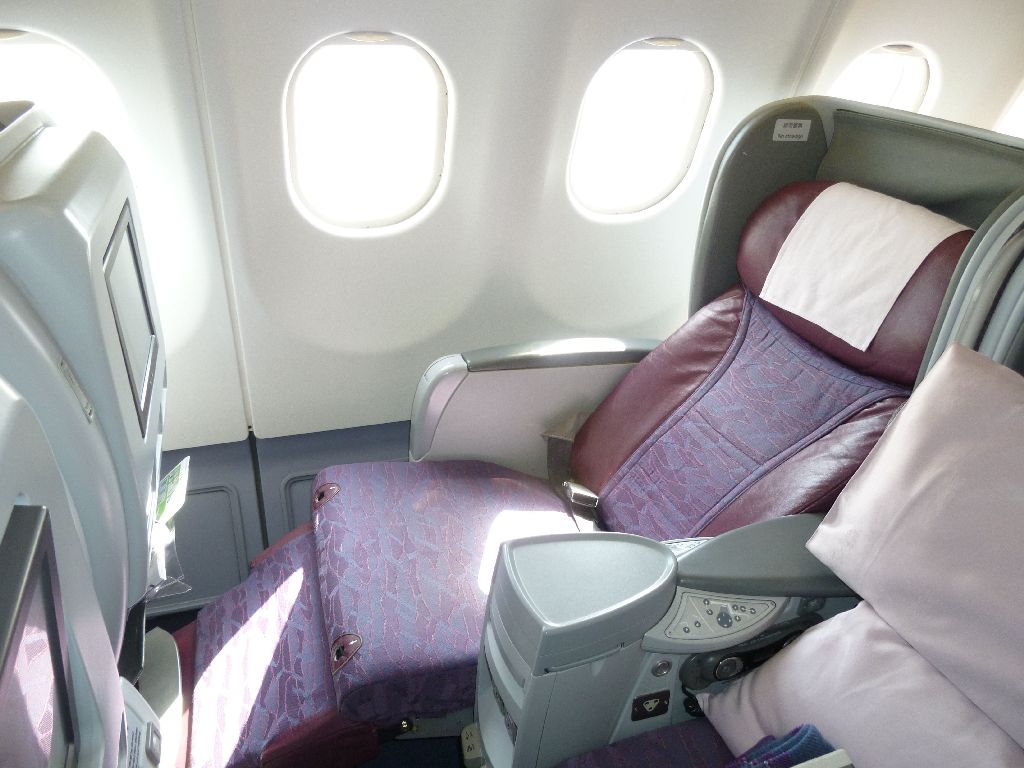
A hole to inflate the flotation cushion?

The seat pitch is enough for anybody, but the seat design precludes keeping your laptop during the take-off and landing, which is a nuisance for me.

A FA will put it in the luggage racks each time

In the centre, potentially useful areas for storing personal items


The electric plug only seems to be compatible with E/F type: it does not fit and you need a Type A adaptator, as is often the case. During take-off, the 110 VAC LED indicator was red. It shifted to green thereafter, without delivering a single milliamp to my laptop. A demerit in comfort (a small one because my laptop's battery had enough autonomy for that flight).
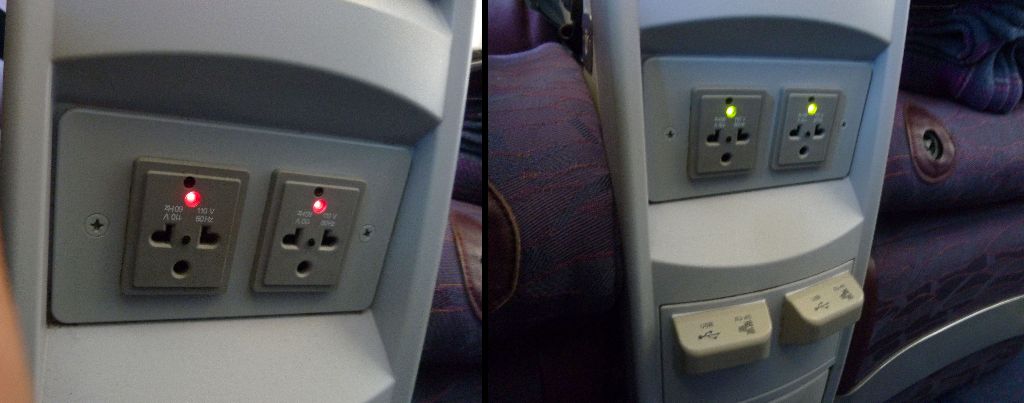
I did not try these headphones

A DL plane lined up for take-off

ANA 738 ready to go

We taxi away from the terminal

Given the direction and speed of the wind, we should have a short take-off run

Direction Runway 36

A last look at the Dreamlifter. I posted a small portion of all the pictures I took of it ;)
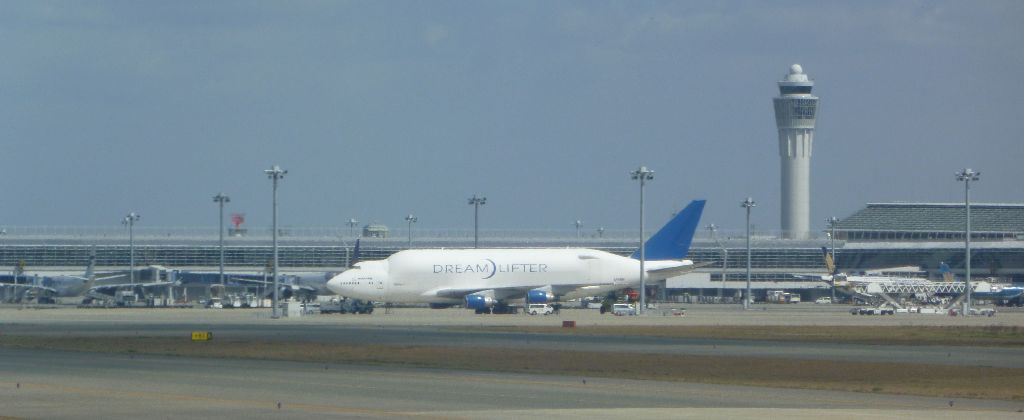
A LH A340 LH behind us
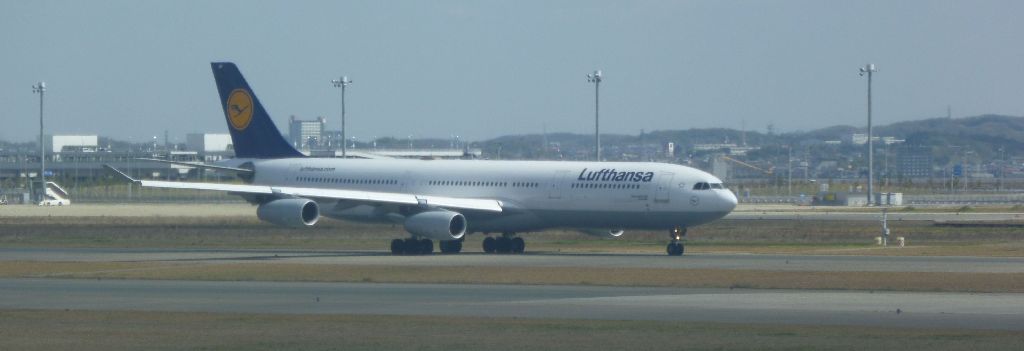
I knew it, the runway was three times longer than needed. See here the T layout of the terminal.

… and the two bridges (rail and road) connecting NGO to Honshu. NGO is a reduced scale KIX: rather than fighting it out in Nagoya like before in Narita to build the new airport on existing land, the Japanese took the horrendously option of building an artificial island in the bay.

The plane gains altitude and turns in the bottom of the bay of Ise. Nagoya is on the horizon.
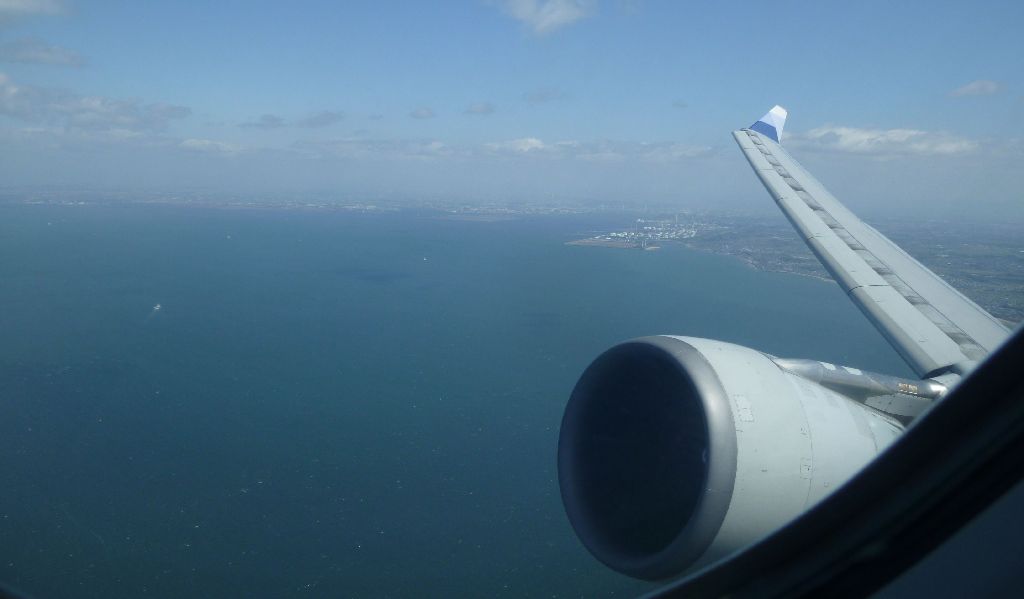


The Kumozu River on the left and the facilities of JFE Engineering.

According to Google Maps, there is a helipad next to the base of the jetty, and a race boat harbor in the rear. Oh yes?

Matsusaka harbor, on the west bank of the bay of Ise, and the Kushida River in the foreground
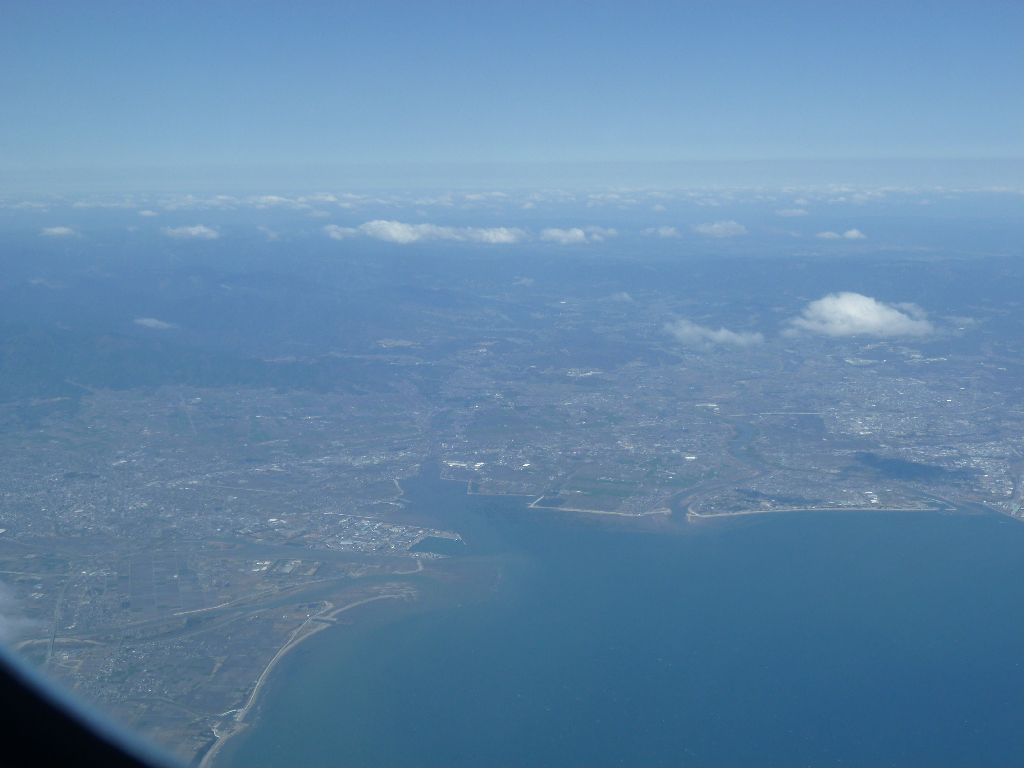
We cross the Kii peninsula, heading due south. Kushida City in the background and the Kushida River in the foreground.

A close up on the private Kintetsu railway line which serves the very famous Ise shrine.

We move away from Kushida and its river in the background; how could you have aerial views of the Japanese countryside without a golf course? This is the Ise Country Club.

The Ise tollway, bottom left, and the rice field grid pattern of Tokida village, and the same Kushida River in the background.

The meanders of the Miyagawa (-gawa means river)

A winglet pause during Japanese Geography 101

Civil engineers had fun building the Ise expressway. The tolls are very expensive in Japan; you can understand why.

The Miyagawa, and Misedani village (at the confluence, towards the left)

A close up on the left part of the previous picture, a few seconds later.

Miyagawa Reservoir, bordered with Highway 53 on the east coast, and Miyagawa Dam on the right. The Japanese were not creative when giving names here.

It becomes really unpopulated thereafter. You can easily forget when visiting Japan that 85% of its surface is unsuitable for any construction, because of the poor structural strength of the terrain, compounded with the seismicity.

Snow on the same summits seen during the previous flight. If I am not mistaken, this is Mount Hachigyodatake, with Shakadatake in the foreground. Then, Yoshino, the place to see cherry tree blooming is on the left in the background. Beyond the picture limits Koya-san, a mythical pilgrimage center in Japan.

We finally leave Honshu somewhere at the south-west extremity of the Kii peninsula.

The small Muroto town, at the south-east extremity of Shikoku Island.


Shintomi (1st valley) and Takanabe (2nd valley) and Nyutabaru Japan Self Defense Air Force base, on Kyushu island
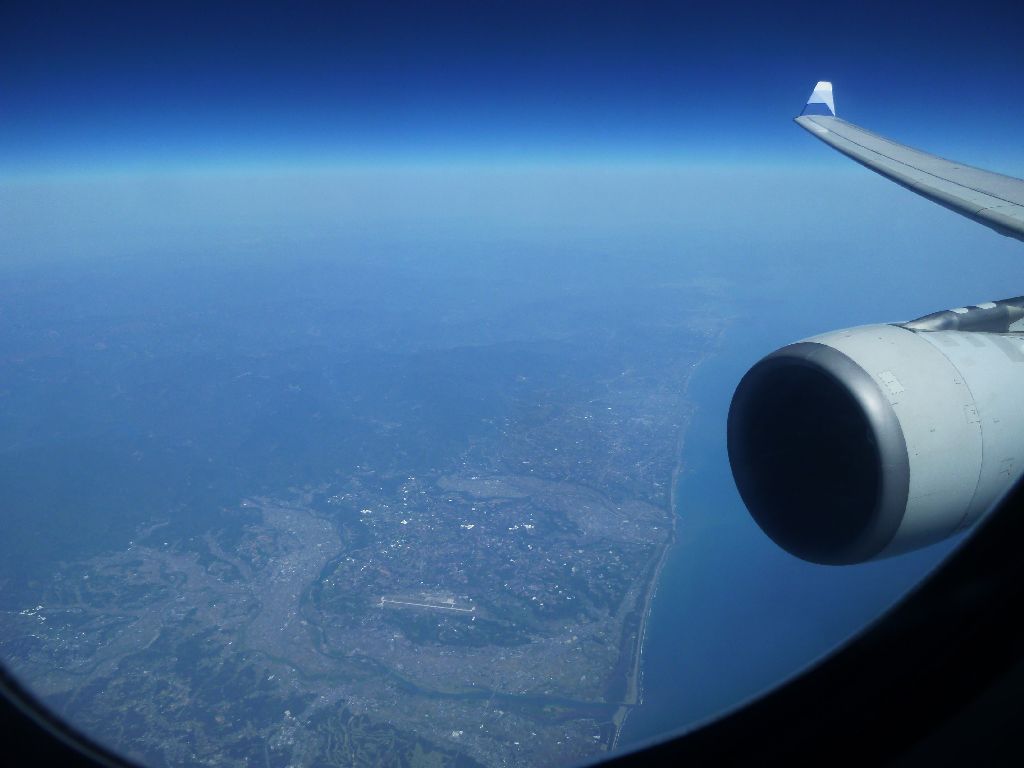


From the foreground, mounts Takachiho, Kirishima and Io, and Kobayashi city in the bottom right.

Kirishima, in the bay of Kagoshima

Kagoshima, a tourist center at the southern tip of Kyushu. The plane passed above the very photogenic Sakurajima volcano, located on the island lower right, in front of the harbor, which continuously sends volcanic ash in the sky.

The coast near Minamitsuma

Noma Mount and peninsula, nearly at the southern end of Kyushu.

It is the end of Japanese landscape spotting, and time for inspecting the toilets. Unlike VN, there is deodorant and perfume. I did not try both together.

Another equipment for fathers caring for their baby.

This is the menu distributed shortly after boarding. I took the Japanese option, presumed to be better for a flight departing from Japan and I was not disappointed.

Since I was busy taking pictures of the landscape (see above), the FA set the tablecloth and the tray on the other seat's tablet.

I shifted it to my tablet, so the tablecloth is less carefully adjusted here, but the presentation was worthy of a kaiseki meal. The dark bowl contains of course hot miso soup. There is of course no cutlery (it would be a sacrilege!), but varnished chopsticks. I would expect them to be lacquered in First class, but they are adequate in business. Just looking at this tray is the promise of a great culinary experience.

The FA passes with a bread basket and I take one with a European reflex. It actually does not belong in the menu.

Even less so that she gives me butter which would be unspreadable with chopsticks. That is not an issue, I do not care much for bread and butter.

You can't see it, but the eating it was up to its visual appeal, for whoever likes Japanese gastronomy. There was afterwards a plate of fruit which were equally artistically cut and laid out,

… and a very traditional very sweet dessert.

On the side, this is the cover of the small wooden knife for cutting it. There again, the presentation was flawless. The coffee was substandard (OK, I should have had tea…), but this dessert is a perfect match for it.

After the meal, we reach the cloud cover of Taiwan: there is nothing left to see before reaching the coast, with a direct approach to TPE's runways. The view on that side is non-descript, and the lighting is wrong on the other side. You can see the divided highway which circles the north coast of Taiwan, and was for a long time the only real road link between the west and east coasts of Taiwan.
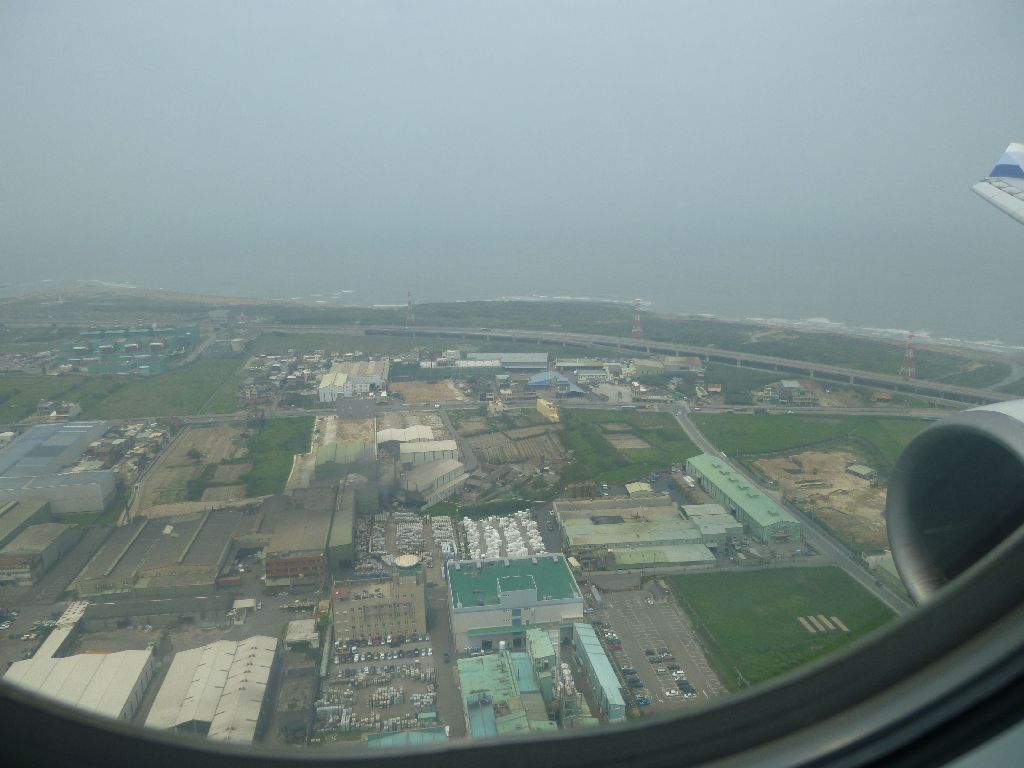

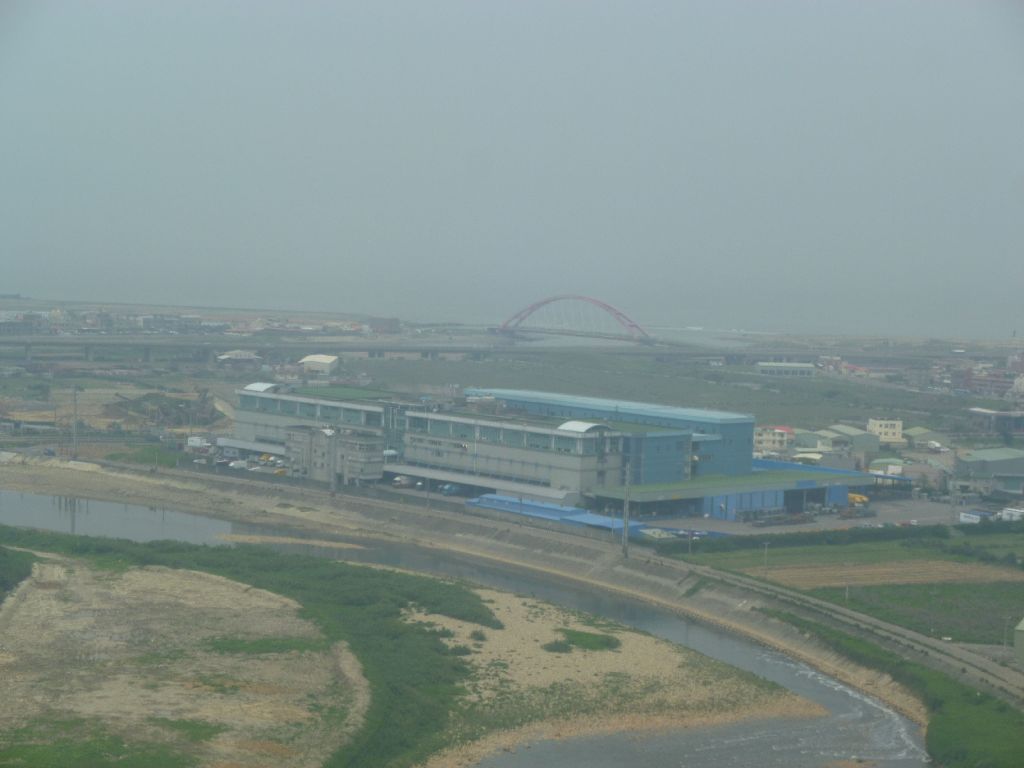
Evergreen's hangar and the expressway towards TPE

Far Eastern Air Transport's 757s in storage close to the runway threshold


A CI 744

A completely missed framing of half a dozen BR cargo MD-11s

TPE's fire department recently bought a 732 from the late Grand Air (Philippines) to replace the A300 which was not very representative of the planes using TPE. Whether you are taxiing or driving on the expressway out of TPE, you need sharp reflexes to shoot it on the fly, even though neither plane nor plane spotter is flying.

CZ A321

HU 738

CA A321

JL 767

The alignment of the vertical stabilizers

A loooong corridor. The passengers did not choose to exercise: the travelator is stupidly moving in the wrong direction!

At long last a place where a father can take care of his baby!

Last chance for buying duty-free stuff

This is one of the few times when I am happy to hold a Taiwan resident's card, because I never saw such a line at the All other passports immigration line. It was nevertheless going forward quickly. I had a negligible waiting time, but the H7N9 epidemic did have a side effect here: all the policewomen had a face mask, which degraded the attractiveness of her smiles.

One of my favorite pictures in TPE

But nobody is waiting for me here

… and I am going to take as usual Kuo-kuang's bus 1819 to the central station, for a reasonable 125 TWD fare

The same fire department's 732, from the bus

Unusually, I arrive in Taipei in the middle of the day: these are the new express lanes to Taipei which were then close to completion (they are now opened to traffic).



The expressway toll station. ETC means Electronic Traffic Control, i.e.; payment with a contactless badge. Ticket means payment with a prepaid ticket which can be bought in sets of ten in convenience stores. All that is history: in July that year, all toll gates were due to be dismantled and replaced by zero speed reduction ETC gantries spread along the tollway, which I saw before their commissioning.

I arrived just in time for my Chinese class. My teacher smiled when she discovered my creative routing: You really never do anything like the others. She knew she could expect that from me, much as I expected similar road adventures from her: she made it back by land all the way from Cambodia to Xiamen, China, and the ferry to the Taiwanese island of Kinmen, after her graduation and volunteer work there.
These were unforgettable vacations, but I was back with my lovely and inimitable Mandarin teacher, my Filipina cleaning lady, my Taiwanese colleagues and all what made life in Taipei unlike anywhere else. I was back home in Taiwan!
Afterword
I now propose a tourist bonus on Ho Chi Minh City which you can skip if you only car for aviation.
During the Vietnam War, the Vietminh digged with hand tools an incredible network of camouflaged tunnels in the region of Cu Chi, to protect themselves, hide and launch commando attacks up to the heart of US military bases.
They can be visited in Ben Duoc and Ben Dinh : the two sites are quasi identical and there is no point in visiting both. The tunnels were much smaller than in Vinh Moc : at most 80cm high, and sometimes so narrow that crawling was the only option.

These two fighters are on display at Ben Duoc, in front of a VIP welcome building, away from the route of the groups of tourists, without any explanation.

The older one on the right is a MiG-17, which was also used extensively during the Korean War. The air intake divided in two to leave space for the cockpit, before joining behind it in front of the reactor. It was armed with a 37mm cannon (below left on the picture) and two 23mm cannons (below right), with markedly different ballistic characteristics: some American pilots found themselves uncomfortable between the 23mm trajectory above and 37mm below.

The much larger MiG-21 was a supersonic aircraft, whose recognizable mobile front cone shut most of the air intake at high speeds. The seven stars painted on the fuselage allow its identification: this was the plane of Dang Ngoc Ngu, the only Vietnamese ace who scored seven victories in a MiG-21 against the Americans.

This plan on static display does not fly anymore, but the MiG-21 has an incredible longevity: I saw several at Da Nang's airbase when taking off from DAD, a mixed military and civilian facility.
Let's go back to Saigon. In the days after April 21, 1975, a poor quality black and white picture went around the world: Vietminh type T54 tank number 848 crashed through the front gate of South Vietnam's presidential palace in Saigon.

The original is outside the Army Museum, but a twin as well as a T59 which crashed without witnesses through a side entrance is exposed on the grounds of the palace.

Decorative tanks or cannons in front of a presidential palace is nothing very unusual, but this is the only one that I know of where the cannons are pointed towards the building, not the outside. The symbol is there …

The same Army Museum keeps Nguyen Thanh Trung's F5, who defected on April 8, 1975 (in the final days of South Vietnam) and machine gunned the presidential palace; this one is another aircraft of the same type.

Note that the South Vietnamese flag and markings are cancelled with a thin black cross, to remind that the Communist Party which to this day is in power in the unified country never acknowledged the legitimacy of the southern government.

A UH1 helicopter similar to that used by the South-Vietnamese president, exposed on the palace's rooftop helipad, also with crossed markings.

I am no deriding the crossed markings, because the livery of the Me-262 on display in the fascinating Deutsches Museum in Munich is slightly inaccurate: the swastika is missing on the vertical stabilizer, because public display of Nazi insignia is prohibited by German law.

The South-Vietnamese presidential palace, which became redundant apart from rare official receptions, remained virtually unchanged, frozen in its 70's design, equipment and furnishing. It is very rare case of a modern presidential palace which can be entirely visited, and that is well enough to devote half a day to visiting it.
The local power is now located in the seat of the People's Committee, the local equivalent of the City Hall, in a Renaissance building.

Signs curiously prohibit taking pictures from the sidewalk alongside that building, and the guards enforce that with whistles, but there is no restriction when you are on the opposite sidewalk.

This tourist bonus is very martial, but could it be otherwise? Sure, the Vietnam War ended nearly 40 years ago, the French colonial adventure nearly 60 years ago, and both the American and French visitors are now peacefully welcome in Vietnam.
But in our modern civilization, wars keep killing and mutilating long after they are officially over. Landmines are equally the poor's weapon of choice and that of the richest nation on earth, who dumped millions of tons of cluster bombs in Vietnam.
This visitor of the Reunification Palace was not born when the war ended, but the war tore her two hands off.

Cursed be wars!
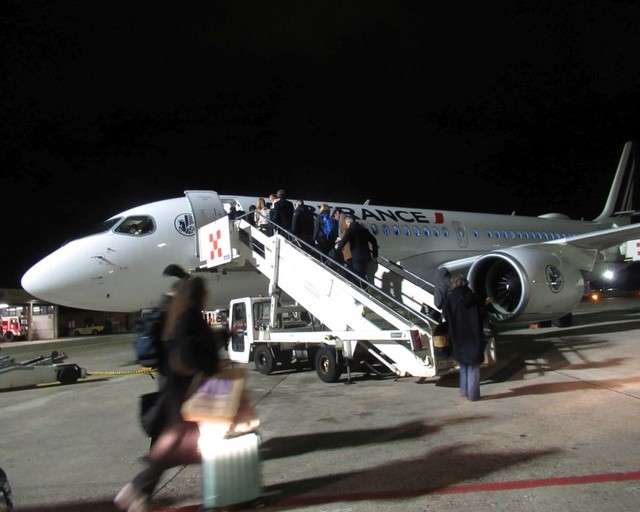
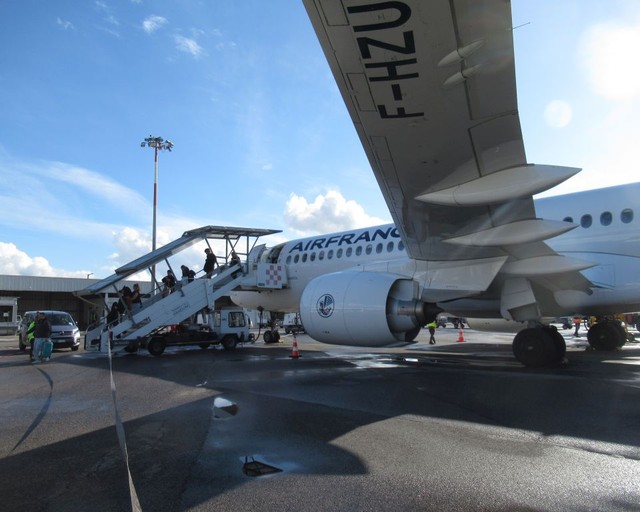


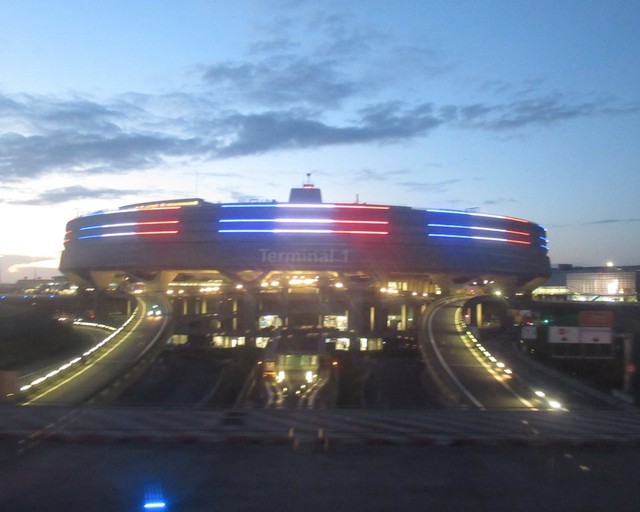
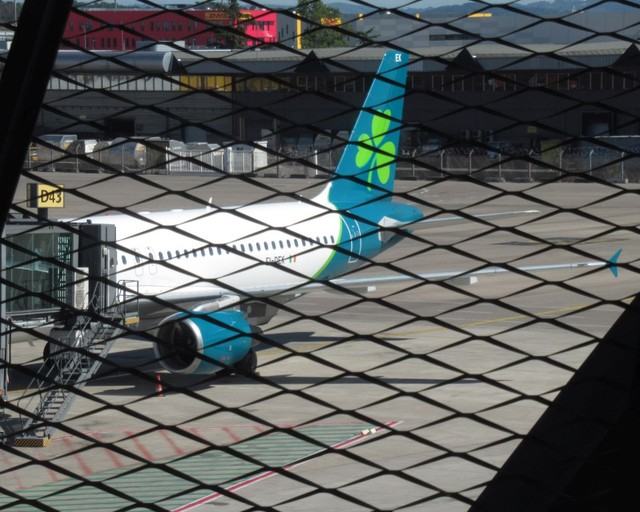

Hello,
Nice FR again.
Many pictures don't show though. There are too many to give the count, sorry.